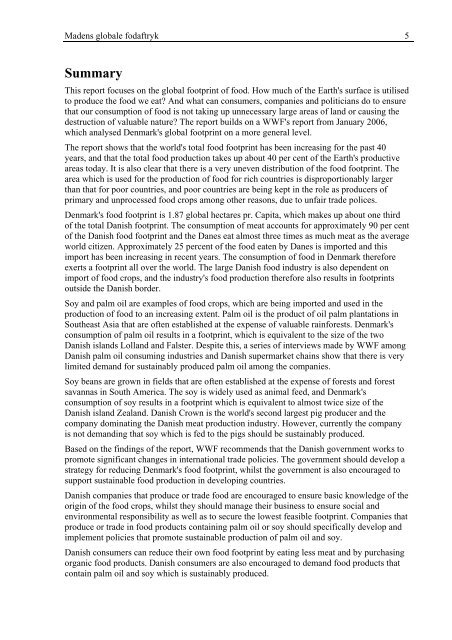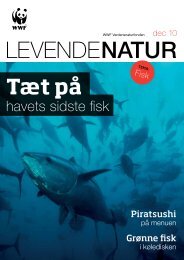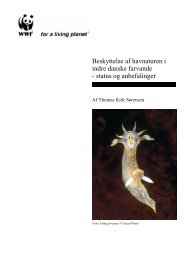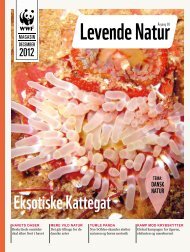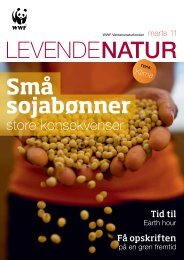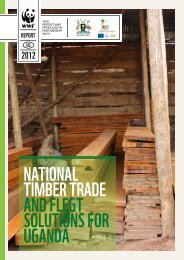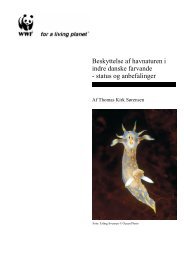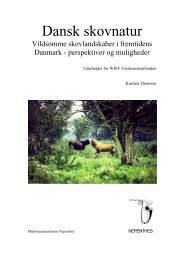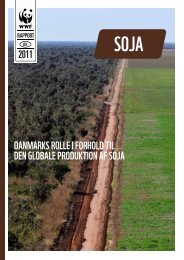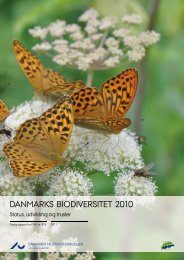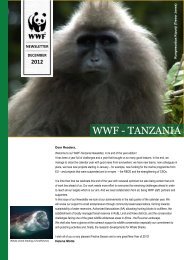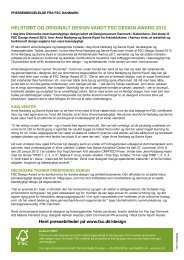You also want an ePaper? Increase the reach of your titles
YUMPU automatically turns print PDFs into web optimized ePapers that Google loves.
<strong>Madens</strong> <strong>globale</strong> <strong>fodaftryk</strong><br />
Summary<br />
This report focuses on the global footprint of food. How much of the Earth's surface is utilised<br />
to produce the food we eat? And what can consumers, companies and politicians do to ensure<br />
that our consumption of food is not taking up unnecessary large areas of land or causing the<br />
destruction of valuable nature? The report builds on a <strong>WWF</strong>'s report from January 2006,<br />
which analysed Denmark's global footprint on a more general level.<br />
The report shows that the world's total food footprint has been increasing for the past 40<br />
years, and that the total food production takes up about 40 per cent of the Earth's productive<br />
areas today. It is also clear that there is a very uneven distribution of the food footprint. The<br />
area which is used for the production of food for rich countries is disproportionably larger<br />
than that for poor countries, and poor countries are being kept in the role as producers of<br />
primary and unprocessed food crops among other reasons, due to unfair trade polices.<br />
Denmark's food footprint is 1.87 global hectares pr. Capita, which makes up about one third<br />
of the total Danish footprint. The consumption of meat accounts for approximately 90 per cent<br />
of the Danish food footprint and the Danes eat almost three times as much meat as the average<br />
world citizen. Approximately 25 percent of the food eaten by Danes is imported and this<br />
import has been increasing in recent years. The consumption of food in Denmark therefore<br />
exerts a footprint all over the world. The large Danish food industry is also dependent on<br />
import of food crops, and the industry's food production therefore also results in footprints<br />
outside the Danish border.<br />
Soy and palm oil are examples of food crops, which are being imported and used in the<br />
production of food to an increasing extent. Palm oil is the product of oil palm plantations in<br />
Southeast Asia that are often established at the expense of valuable rainforests. Denmark's<br />
consumption of palm oil results in a footprint, which is equivalent to the size of the two<br />
Danish islands Lolland and Falster. Despite this, a series of interviews made by <strong>WWF</strong> among<br />
Danish palm oil consuming industries and Danish supermarket chains show that there is very<br />
limited demand for sustainably produced palm oil among the companies.<br />
Soy beans are grown in fields that are often established at the expense of forests and forest<br />
savannas in South America. The soy is widely used as animal feed, and Denmark's<br />
consumption of soy results in a footprint which is equivalent to almost twice size of the<br />
Danish island Zealand. Danish Crown is the world's second largest pig producer and the<br />
company dominating the Danish meat production industry. However, currently the company<br />
is not demanding that soy which is fed to the pigs should be sustainably produced.<br />
Based on the findings of the report, <strong>WWF</strong> recommends that the Danish government works to<br />
promote significant changes in international trade policies. The government should develop a<br />
strategy for reducing Denmark's food footprint, whilst the government is also encouraged to<br />
support sustainable food production in developing countries.<br />
Danish companies that produce or trade food are encouraged to ensure basic knowledge of the<br />
origin of the food crops, whilst they should manage their business to ensure social and<br />
environmental responsibility as well as to secure the lowest feasible footprint. Companies that<br />
produce or trade in food products containing palm oil or soy should specifically develop and<br />
implement policies that promote sustainable production of palm oil and soy.<br />
Danish consumers can reduce their own food footprint by eating less meat and by purchasing<br />
organic food products. Danish consumers are also encouraged to demand food products that<br />
contain palm oil and soy which is sustainably produced.<br />
5


